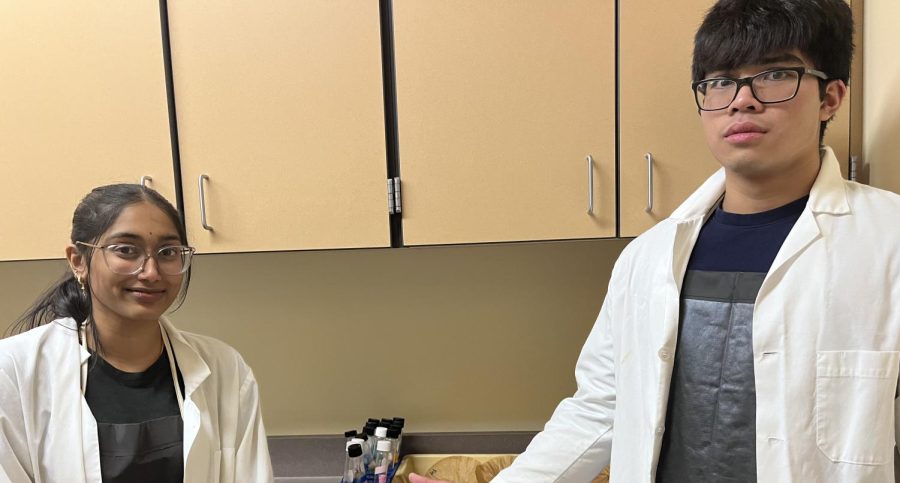Are your groceries out to get you?
High schoolers find microplastics in supermarket fish
Photo provided by Sameera Yatham
Sameera Latham (right) and CJ Chan (left) work in the lab on their project. They have been exploring methods of research and staring their experiments in “lab hours” after school.
Fish are an everyday supermarket food: a commonplace addition to the typical household freezer. Regardless, have we ever stopped to think about what just might be in those scaly creatures we so regularly consume?
Wilsonville High School seniors Sameera Yatham and CJ Chan first encountered this topic in their final AP Biology project last year. Their limited research materials yielded strange discoveries– and more questions than answers.
They decided they needed a bigger platform in order to explore the topic in even more depth in order to answer their burning question: how much plastic do we really eat?
This experiment is their current topic of study for the International Science and Engineering Fair this year: better known as ISEF.
In their work, they are observing the microplastics in the food that we ingest by taking supermarket fish and putting them through various trials in order to measure plastics present in their systems.
Due to their prior research on the topic, they already have some interesting findings. “When we did trials last year we found out there were plastics inside the fish muscles, separate from the digestive system,” Chan relayed.
If plastics are not only present in the digestive systems of fish, what other organisms could this be true for? More importantly, what does this mean for our food– or even our own biology?
The duo wants to see just how expansive their results may become. With previous success exemplified in their research, the continuation of the project simply makes sense.
Yatham sums up their process the best. “[Last year] we looked at chemical testing, we looked at separation from muscles, and those kinds of things. We are hoping to extend it for this project as well, where we are going to do repeated trials, instead of just once.”
Their research has explored many facets; however, the hardest part of their project is seemingly discovering the most efficient way to find plastics in their specimens. They have done trials with chemical detectors and simple microscopes, and are exploring both new and difficult frontiers to answer their question.
While their results are currently only data, Chan understands there is a lot more to their discoveries than meets the eye. “If people are digesting plastic filled fish maybe it is getting into our muscles too– getting out of our digestive systems.”
Plastics in our food is not a new issue, but is one that we do not regularly see numbers or data for. With the discoveries in Yatham and Chan’s project, the general public will be presented with the reality of the presence of microplastics in mundane products–even food.
WIth more and more focus toward the importance of health and food transparency in society, Sameera and CJ aren’t the only ones with speculations surrounding plastic in unexpected places.
An article by Matthew Rosa of Salon.com inquires about the issue with a bold title: “There may be plastic in your meat— and there is definitely plastic in your body.”
In this article, Jane Munke–a member of the nonprofit “the Food Packing Forum”– illuminates the reality of the food we consume. “I’d say that almost everything that one eats has traces of plastics. This is either tiny bits of microplastics or plastic chemicals. Both can originate from plastic food packaging, or food processing equipment or, sadly, from environmental pollution.”
This issue is much bigger than two highschoolers with a question. Their research could simply cause exposure to the topic, but it is most likely much bigger than that.
Their data could allow for new opportunities in further modern biological research, answers to modern issues relating to plastic consumption, and even necessary future regulations on mainstream foods.
Whether their discoveries influence the actions of small consumers in their weekly journey to the grocery store, or wreak havoc on the societal normalities surrounding food culture, their data is assuredly some to heed in ISEF this year, and may have us all thinking twice about our future supermarket finds.











